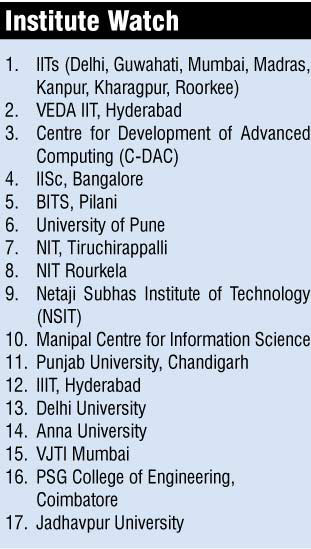How to get the entry?
A bachelor’s degree in electronics, communications or instrumentation is a prerequisite. Companies look for candidates with knowledge of the circuit design, VLSI design, microcontrollers, IC design, C programming, Assembly-level programming, etc.
[stextbox id=”info”]
“The salary across the market is very good for experienced candidates. It is also equally rewarding for freshers in terms of exposure and growth.”
— Teresa Mishra, general manager-talent acquisition, Wipro Technologies .
[/stextbox]
There are many universities in India that offer good education in this field. All IITs, NITs and other Tier I and II colleges offer high-quality education in chip designing. Some of the courses offered at these institutes cover microelectronics, microprocessors, VLSI design, and digital and analogue systems.
 “We work closely with many universities in the country and help them with setting up of labs so that students get opportunities to work on practical aspects as part of their coursework. We also help universities to periodically revise their syllabus to ensure that students are studying the most updated technology and the latest breakthroughs during their study years,” says San-jay Bhan, director-HR, Texas Instruments India.
“We work closely with many universities in the country and help them with setting up of labs so that students get opportunities to work on practical aspects as part of their coursework. We also help universities to periodically revise their syllabus to ensure that students are studying the most updated technology and the latest breakthroughs during their study years,” says San-jay Bhan, director-HR, Texas Instruments India.
Wipro Technologies primarily looks for graduates in engineering and postgraduates in technology. “All IITs, NITs, BITs, Anna University, VJTI Mumbai and PSG Coimbatore offer good training on this subject,” shares Teresa Mishra, general manager-talent acquisition, Wipro Technologies.
IIT Bombay offers a dual-degree programme combining B.Tech in electrical engineering and M.Tech in microelectronics. The fee structure for this five-year course is the same as for all other IIT courses, i.e., Rs 23,000-24,000 per semester. Some of the subjects taught as part of this programme are VLSI design, analogue design, embedded systems, FPGAs, physics of transistors, systems-onchips, VLSI testing and embedded systems.
At IIT Kharagpur, students can learn digital design, analogue design and VLSI engineering. They are taught analogue VLSI circuit, digital VLSI circuit, semiconductor design modeling, architectural design of VLSI circuit and VLSI technology for fabrication.
Money matters
The private sector offers lofty pay packages to candidates having a suitable exposure in the form of proper industrial training or systematic industry-defined project work. Typically, the starting salary for a fresher (diploma or degree holder) is Rs 400,000 upwards per annum, with the variation depending on the nature of the organisation and competency level of the candidate. Design engineers are the most sought after because of the industry’s emphasis on continuous new product development, miniaturisation and innovation in integration.
Sanjay Bhan shares, “A career in the semiconductor industry is highly rewarding both
[stextbox id=”info”]
“We work closely with many universities in the country and help them with setting up of labs so that students get opportunities to work on practical aspects as part of their coursework.”
labs so that students get opportunities to work on practical aspects as part of their coursework.”
— Sanjay Bhan, director-HR, Texas Instruments India
[/stextbox]
for new college graduates and experienced people. Today, in India, we have many local as well as international companies that are doing highly innovative work that is valued globally.” [stextbox id=”info”]
 “Apart from multinationals, the government also hires chip designers for space and defence research.”
“Apart from multinationals, the government also hires chip designers for space and defence research.”
— Anindya Sundar Dhar, associate professor and faculty advisor, microelectronics and VLSI design, IIT Kharagpur
[/stextbox]
“The salary across the market is very good for experienced candidates. It is also equally rewarding for freshers in terms of exposure and growth,” quips Mishra.
“The annual salary for postgraduates may range from Rs 600,000 to 800,000 and for Ph.D holders from Rs 1.1 to 1.8 million,” informs Prof. Rao.
Anindya Sundar Dhar, associate professor and faculty advisor, microelectronics and VLSI design, IIT Kharagpur, adds, “The salary for an M.Tech from IIT starts at Rs 1 million per annum. Apart from multinationals, the government also hires chip designers for space and defence research. They look for sound domain knowledge.”
Skills in demand
Intel, IBM, Texas Instruments, Analog Devices, Cadence and Synopsis are some of the big recruiters in India. Companies want students who have designed a chip as part of their curriculum and also tested it in silicon.
Prof. Rao shares, “Our students not only design the chip but also send it for fabrication to companies that provide this service and get it tested. They get exposure in design tools and silicon implementation.”
Texas Instruments looks for candidates with an understanding of the fundamentals of electronics. “There are many branches in electronics today such as VLSI, DSP, electronic communications, power electronics and embedded systems. We expect the prospective candidate to have studied at least one course in these branches. Although we do provide job-specific training, it is expected that the candidate has technical knowledge required to absorb the training. For example, a training session on VLSI may require the student to know about MOS transistor operation, CMOS circuits, logic gates and flip-flops, operational amplifiers, feedback amplifiers, poles and zeroes,” Bhan states.






